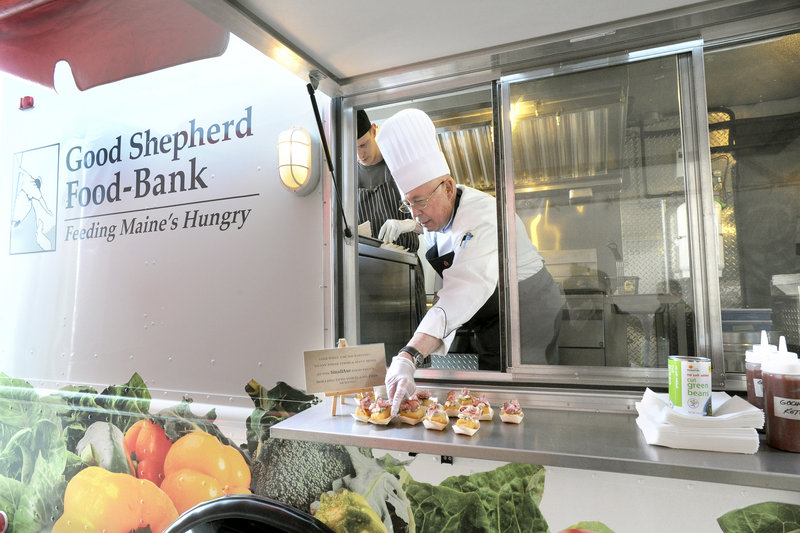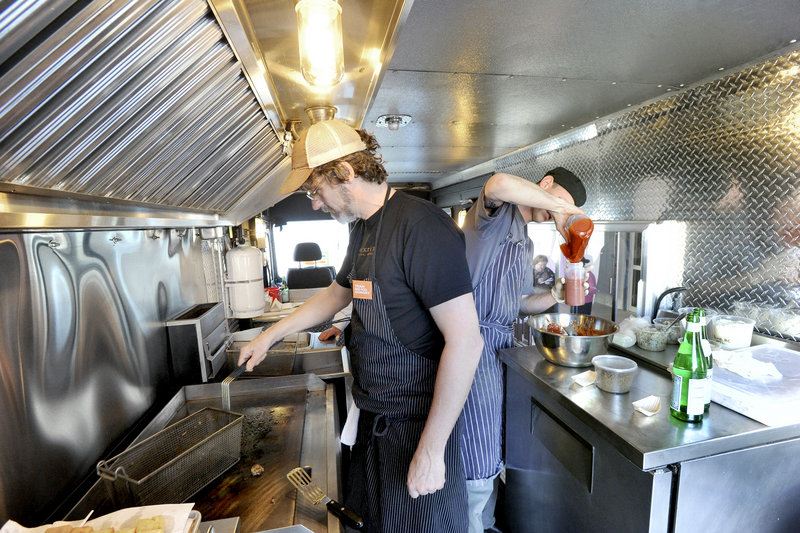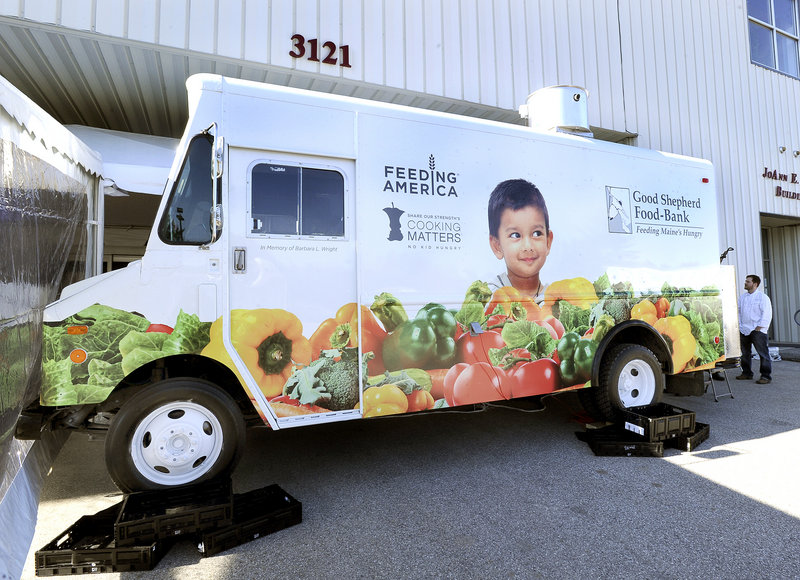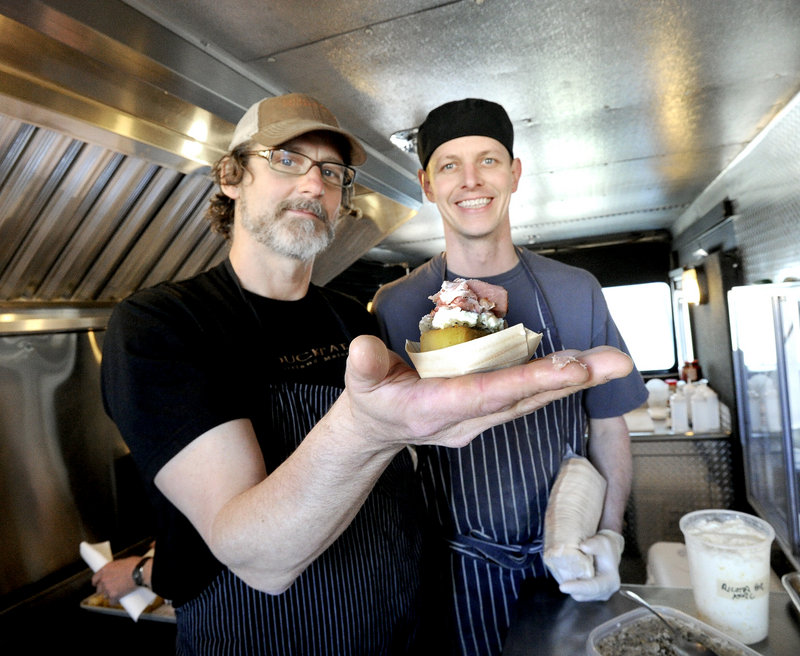AUBURN – There are sizzling sounds coming from the food truck parked just outside the Good Shepherd Food-Bank’s giant warehouse.
Rob Evans steps outside for a moment into the parking lot, looking more like a line cook than a James Beard award winner and “Chopped” champion. He has a big smile on his face as he reports that, other than a problem with a water pump, “so far all of it’s running really well.”
“We’re testing out the equipment, trying out the griddle, making sure that’s seasoned right,” Evans said. “Fryolater’s working great. A little bit of prep, and we’re going to be ready on time.”
Evans was at the food bank’s annual gala last Thursday, christening a project close to his heart: A new food truck that will make it easier for Good Shepherd, in partnership with Maine chefs, to feed the hungry in all corners of the state.
Evans, the owner of Duckfat in Portland, has been working as a sort of chef consultant on the truck, helping find the right equipment and making sure the truck is laid out the way a chef would want it.
The tricked-out food truck, which is nearly 20 feet long and about 13 feet high, made its debut last Wednesday at the Maine Restaurant & Lodging Expo at Portland’s Civic Center. Ironically, the city’s restrictive new food truck rules made it impossible for chef Jeff Landry, owner of the Portland restaurant The Farmers Table, to actually put on a cooking demonstration for restaurateurs at the event because the truck was not parked in a food-truck friendly zone.
So Evans had the privilege of being the first chef to cook in the truck. He and Karl Deuben, a Portland chef who is rolling out his own food truck this spring, made cheeseburger hand pies and other appetizers for the guests at the food bank’s dinner.
The truck’s next scheduled gig will be at the Brews & Tunes event at the Kennebunkport Festival in June, when Landry will be cooking out of its kitchen.
There are a handful of non-profit food trucks around the country, used in myriad ways to feed the homeless and hungry. In Maine, the Good Shepherd’s new truck is expected to help feed the 15 percent of households in the state that don’t have enough food and the one in four children who go hungry each day.
SHAKEDOWN CRUISE
The food bank will probably spend the entire next year testing out ideas for how best to use its truck, said Kristen Miale, president of the organization. First and foremost, she said, the truck will be tagging along with Good Shepherd’s food mobile, which is a kind of roving food pantry that distributes fresh produce and other foods to underserved areas of the state and neighborhoods with low-income housing.
If a food pantry closes, or can’t keep up with the need in a particular area, the mobile food bank swoops in and does a food drop, a one-time event that usually lasts three or four hours and delivers 7,000 pounds of food. People in need bring boxes and stand in line, sometimes for up to three hours.
The food truck, Miale said, could be used to pass out hot soup or sandwiches to those people waiting in line, or the staff on the truck could use it to teach them what to do with the fresh produce they’ll be taking home.
“A lot of people don’t know what to do with some of the fresh produce,” Miale said, “so our Cooking Matters crew goes along and kind of sets up a cooking demonstration right there. It’s been really successful, but the problem we have is you’ve got to bring in the plug-in burners, you’ve got to get an extension cord, you’ve got to bring in a cooler. It’s hard. And a lot of times our food mobile, they’re in the middle of a field, you know?”
Miale said the truck also could be used for summer food service, particularly in rural areas. Good Shepherd has summer food programs where kids can come and get a free lunch supplied by the same federal program that supports free lunches in schools. Typically, hungry kids come to a central location to pick up the meals, but that’s not always possible in rural areas.
“We saw this in Connecticut and Indiana, where they actually hand out sandwiches from a food truck,” Miale said. “They drive around, and that’s how they distribute the summer meals for kids.”
Miale also sees the value in using the truck as a vehicle for fundraising and public awareness, calling it “our version of the L.L. Bean ‘bootmobile.’ ” (The truck is covered in colorful vegetables and has the Good Shepherd logo and website address printed on it. A sign on the back says “Help Feed a Neighbor.”)
Chefs could volunteer their time for a day, with all proceeds from food sales going back to the food bank.
Evans and Landry see value in allowing chefs to rent the truck for a week or a weekend. Chefs who are considering opening their own food trucks but aren’t sure if they’d like it, or whether it’s worth the investment, could take the truck out for a spin and give the food bank exposure at the same time.
“If it works for you, great,” Landry said. “If it doesn’t, then at least you know and you didn’t spend 50 grand on a truck.”
Courtney Kennedy, the nutrition and education manager at the food bank, sees mutual benefit in such an arrangement.
“We see it as a partnership where we let them dabble, but we need something from you,” Kennedy said. “That’s me saying to them, ‘I have a Cooking Matters class coming up, you know, I need you to be the chef in the Cooking Matters class.”
TAPPING THE VOLUNTEER SPIRIT
Rob Evans first brought up the idea of a non-profit food truck in a talk with John Woods, who runs Share Our Strength-Maine, an organization that fights childhood hunger. Evans liked the idea of chefs volunteering to take a food truck to poor neighborhoods on a cold day and simply passing out hot soup to children who might not have had anything to eat that day.
Evans also likes the idea of serving food to the general public from the truck, but using the Panera Bread model of asking people to pay whatever they can afford for a meal and then donating any extra money to feed the hungry. People could pay $20 for a bowl of soup, for example, and subsidize hungry people who come to the truck but can’t afford to pay anything.
“Make it good soup so people who could afford $20, maybe, or $10 or $5 can donate, and those who are hungry can just take it if they can’t afford it,” Evans said. “People tend to be more generous, I feel, if it’s for charity. If people can afford it, throw down extra.”
Evans would like to see local chefs take out the truck on a consistent basis, Monday through Friday, and serve lunch out of it to give the food bank more exposure. It could be rented out on weekends and taken to festivals.
“If that thing was at the Fryeburg Fair or Common Ground Fair for a week, someone could kill it and at the same time promote Good Shepherd,” Evans said.
Serving food from a truck could also help lessen the stigma of accepting free food. Children who aren’t getting food at home, for example, are offered breakfast at school every day, but they often won’t take it. They know if their friends see them going to the cafeteria in the morning, it’s because they didn’t have breakfast that day. To save embarrassment, they go hungry.
But pull a food truck up to the school, Landry says, and “those kids are going to want to eat breakfast.”
“You make it exciting for them, and you take away the stigma of not having food in the house that’s nutritious,” Landry said. “You bring it to them, and they’re going to think it’s the best thing since sliced cheese. They’re going to be excited.”
Staff Writer Meredith Goad can be contacted at 791-6332 or at mgoad@pressherald.com
Twitter: MeredithGoad
Send questions/comments to the editors.






Success. Please wait for the page to reload. If the page does not reload within 5 seconds, please refresh the page.
Enter your email and password to access comments.
Hi, to comment on stories you must . This profile is in addition to your subscription and website login.
Already have a commenting profile? .
Invalid username/password.
Please check your email to confirm and complete your registration.
Only subscribers are eligible to post comments. Please subscribe or login first for digital access. Here’s why.
Use the form below to reset your password. When you've submitted your account email, we will send an email with a reset code.